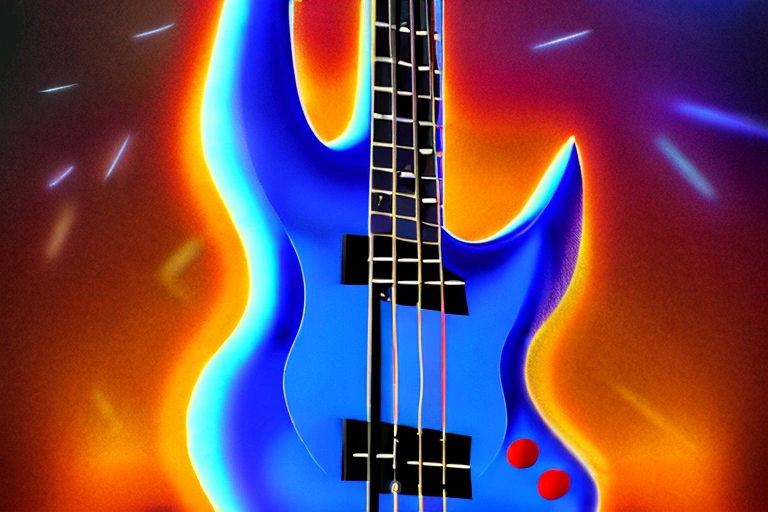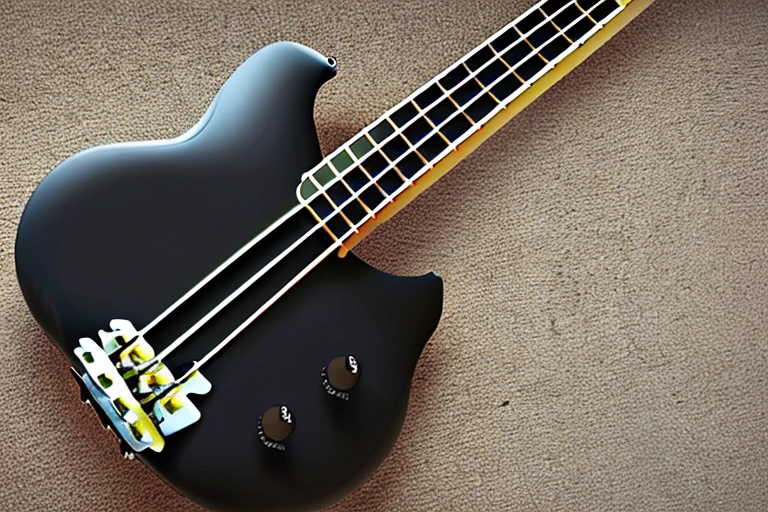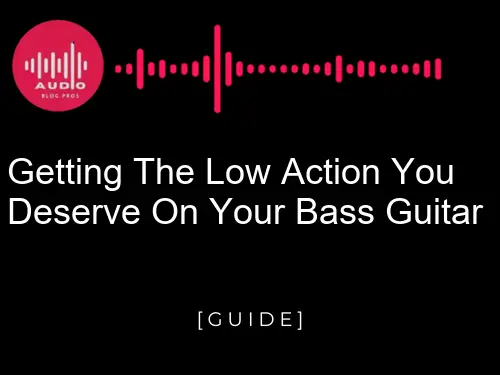Are you sick of constantly having to fight with your bass guitar to get it to play the right notes? Are you tired of the fret buzz and poor intonation? If you’re looking for a fix, then this blog post is for you. We’ll be exploring the best ways to get the low action on your bass guitar that you deserve. Read on to find out how!
- Introduction to Low Action on Bass Guitars
- What is Low Action?
- Benefits of Low Action on Bass Guitars
- Adjusting the Truss Rod for Low Action
- Adjusting the Bridge for Low Action
- Checking and Adjusting the Nut for Low Action
- Intonation and Tuning for Low Action
- Setting the String Height for Low Action
- Tips for Maintaining Your Bass Guitar's Low Action
- Common Problems with Low Action on Bass Guitars
- Conclusion: Getting the Perfect Low Action on Your Bass Guitar
- FAQs About Low Action on Bass Guitars

Introduction to Low Action on Bass Guitars
There are a few things you can do to get the low action you deserve on your bass guitar. The first is to make sure the strings are properly tensioned. You can also adjust the bridge, neck, and strings. You can also get a low-action bass guitar kit.
What is Low Action?
Low action is the lowest possible action on a bass guitar, meaning the strings are close to the fretboard. This low action is ideal for players who want to play fast and hard without having to worry about the strings hitting the fretboard. Low-action bass guitars are also popular among bassists who want to create a heavier sound.

Benefits of Low Action on Bass Guitars
Low-action bass guitars are popular among bassists for a variety of reasons. They offer a more comfortable playing experience, as the strings are closer to the fretboard. This also allows for easier fretting and faster playing. Additionally, low-action bass guitars are easier to play in the lower registers, as the strings are less likely to cause interference with other strings.
Low-action bass guitars can also be more responsive to your touch. This is due to the fact that the strings are closer to the fretboard, which allows for more accurate finger placement. As a result, low-action bass guitars are perfect for players who want a responsive instrument that they can easily control.
Adjusting the Truss Rod for Low Action
If you’re finding that your bass guitar’s action is higher than you’d like, there are a few things that you can do to adjust it.
The first step is to determine the cause of the high action. This may be due to a number of factors, such as inaccurate intonation or cracked fretboard binding. Once you know where the issue lies, adjusting the truss rod will correct it.
To adjust the truss rod:
- Remove the nut and saddle from the bass guitar neck. If there’s a Floyd Rose Tremolo system installed, remove all five saddles and nuts from both bridge and tailpiece assemblies. If not, remove only one nut at each end of each neck pickup string’s pole piece (the round metal “nuts” at either end of each string). You may need to use a hex wrench or P recess removal tool for some screws; if in doubt about whether or not something needs to be removed, just ask an expert!
- Locate the truss rod on an angle (usually marked with an “A” near its base), inserting a thin-blade screwdriver between two cover plates at one end of the rod and prying them off slightly until they release – being careful not to damage either plate or screwdriver in doing so (a set of needle nose pliers works well here). Be sure to label which plate goes on which side – usually, this is done by numbering them 1-4 from front to back on one side, then matching up corresponding numbers written in marker on another side(s), before replacing covers and screws. Again, ask an expert if unsure!
- Carefully insert the tip of your screwdriver into one open hole along the length of the threaded partway down rod (~5/8″), rotating the handle towards yourself as needed until the button head appears at another end (or alternatively, use photo help online). Twist handle clockwise once (note: slight counterclockwise rotation required when reinserting nut onto saddle after lowering action) until button falls out; repeat for second ‘eye’ elsewhere along same circumference (~5/8″). Replace the original cap if damaged – again gently prying – and then replace both plates over the threaded section with fresh ones (repeat numbering sequence here). Now unscrew mounted rods by hand using four evenly spaced Phillips head screws inside caps; carefully transfer rods & screws overhang across hollow neck toward rear bridge assembly (1); install new studs into mounting caps (2); replace covers and screws (3), and you’re done!
If you find that your bass guitar’s action is still too high, you may need to adjust the intonation. This can be done by adjusting the string height at the bridge or by adjusting the tuners.
Adjusting the Bridge for Low Action
If you’re looking for a way to improve the low action on your bass guitar, you need to adjust the bridge. This is a relatively easy task that can make a big difference in the playability of your instrument.
There are a few things you’ll need before you start: a level, a straight edge, and some sandpaper. First, use the level to make sure that the bridge is level across the strings. Next, use the straight edge to mark the positions of the string saddles. Finally, sand down the positions of the string saddles until they’re flush with the straight edge.
Now that the bridge is adjusted, it’s time to test it out. You can do this by playing some simple chords and seeing if they’re easier to play now that the action is lower. If everything looks good, you can move on to the next step: adjusting the strings themselves.
Checking and Adjusting the Nut for Low Action
One of the most common adjustments bass players make to their instruments is to adjust the bridge for low action. This adjustment can be made by either raising or lowering the bridge or by changing the height of the strings at the bridge.
When checking and adjusting the nut for low action, it is important to remember that the height of the strings at the bridge should be adjusted so that they are level with each other and with the fretboard. This will ensure that the strings are in good contact with the fretboard and will result in low action.
Intonation and Tuning for Low Action
If you want to find a bass guitar with low action, you will need to check the action and, as needed, adjust the nut. Low action is important for smooth, accurate playing.
To check the action, place your hand on the back of the neck and feel for any bumps or kinks. If the action is too high, you can adjust the nut by removing or adding shims to the end of the string saddle. Be sure to replace the shims after you’ve adjusted the nut, or you’ll end up with a warped neck.
To adjust the nut, use a flathead screwdriver to loosen or tighten the bolt that holds it in place. Be careful not to overtighten the bolt, or you’ll damage the neck. Replace the nut after you’ve adjusted it, or you’ll end up with a warped neck.

Setting the String Height for Low Action
A low action bass guitar will sound and play better with a lower string height. Set your strings at around 1/2 inch from the fretboard, which will give you great sounding and low action.

Tips for Maintaining Your Bass Guitar’s Low Action
Keeping your bass guitar low action is important for achieving the desired sound and playing abilities. Here are a few tips to help you maintain low action:
- Check the tuning regularly. If the strings are not in tune, they can cause your guitar to play out of tune. Check the neck and frets for signs of wear or damage, and adjust the truss rod if needed.
- Use proper maintenance tools. A quality string winder will ensure that your strings remain tensioned properly; use a fret polisher on maladjusted or worn frets; lubricated annually with light oil to reduce friction on gears inside the instrument, and clean everything inside and out using a good solvent/cleaner combination (lots of rinsing!).
- Perform regular maintenance checks on electronic components such as pickups, switches, and pots-check connections, replace batteries when necessary, make sure all leads are fully connected (especially ground), etc., before going onstage or taking your bass into a studio session! Many times small problems can become major issues if not addressed promptly!
- Take care of your hands! Proper hand hygiene–including washing with soap and water–is essential for preventing excessive finger sweat from causing dirt buildup within the electronics department of your bass guitar, including in switches and potentiometers, which may eventually result in loss of accuracy or crackling sounds when played.”

Common Problems with Low Action on Bass Guitars
Low action on a bass guitar can be caused by a number of factors, but the most common culprit is poor string height adjustment. If the strings are too high or too low on the fretboard, they will not play in tune and will produce a low action. To correct this issue, you’ll need to adjust string height using a hex wrench or a string height gauge. Once you’ve got the strings in the right spot, you can use a fret file or sandpaper to smooth out any rough spots.
Conclusion: Getting the Perfect Low Action on Your Bass Guitar
If you’re looking for a low-action bass guitar, there are a few things to keep in mind. First, try to find one that has been properly set up by a professional luthier or guitarist. Second, use a fret truss rod tool to adjust the action (lower it if needed) according to your playing style and the size of the fingerboard. Try not to over-adjust the action, as this can cause string buzzes and other problems. Finally, use AquariumSilicone Lubricant on all of your strings every time you change them – this will help reduce friction and improve sound quality.
FAQs About Low Action on Bass Guitars
In this section, we will answer some common questions about low action on bass guitars. First, what is low action? Low action is the action of a bass guitar that is lower than the standard factory setting. This is usually done to improve playability and tone. Secondly, why do I need low action? Low action is necessary for many reasons. First, it allows for easier string bending and fingerpicking. Second, it produces a cleaner sound when played through an amplifier or PA system. Third, it allows for easier rhythm playing and soloing. Fourth, it makes it easier to hit high notes. Fifth, low action makes it easier to learn how to play the bass guitar. Finally, low action can make a bass guitar look better on stage.
Now that you know what low action is and why you need it, let’s answer some common questions about low action on bass guitars.
*How do I adjust my bass guitar’s action?*
There are a few ways to adjust the action of your bass guitar: you can use a spring bar tool, a screwdriver or use a key of X. You will need to find your bass guitar serial number or model number to find the instructions for setting the action. How do I know if my bass guitar has low action?
If you have trouble bending or picking strings with ease, your bass guitar may have low action. You can check your bass guitar’s Action Level using the following guide:
Action Level Guide
If your Action Level is below 5 (the “5” represents the fifth fret), then your bass guitar may have low action. However, if your Action Level is above 7 (the “7” represents the seventh fret), then your bass guitar may not have low action, and you will need to adjust the bridge or nut on your instrument.
How do I adjust the bridge or nut of my bass guitar? To adjust your bridge or nut, remove the strings and locate the bridge or nut on your instrument. You will then need to loosen the screws that hold the bridge or nut in place and adjust it until the Action Level on your instrument matches that of your desired setting (5 for standard factory settings; 7 for lower Action Levels). Be sure to re-install the strings before re-tightening the screws!
In conclusion, achieving the perfect low action on your bass guitar requires careful attention to detail and knowledge of proper techniques. Adjusting the truss rod, bridge, nut, intonation, and tuning can all help to achieve an ideal string height for a comfortable playing experience. It is also important to regularly check these adjustments as well as maintain good habits when it comes to caring for your instrument in order to keep your bass guitar’s low action feeling great. With the right knowledge and care, you can tune up a perfectly playable instrument with low action that suits you best!


